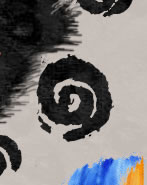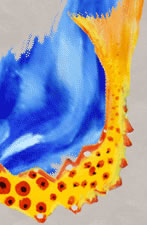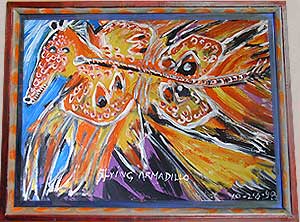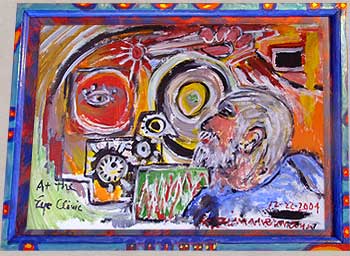 |
Kurt Zimmerman |
 |
|
 |
|
 |
|
 |
|
 |
 |
 |
|
 |
||
Getting it Out |
||

|
||
Born in Germany in 1925, Kurt Zimmerman immigrated at the age of four with his parents to Schenectady, New York. After high school, he was drafted into the Army and sent overseas to fight during World War II. As an American, he performed missions over his native Germany. After the war, he stayed in the service, trained as an electronics technician, and later worked for General Electric as a field engineer. Ironically, General Electric also sent him to Germany to do work on a military defense project. Zimmerman became deeply conflicted over his allegiance to both the United States and Germany and his participation in the war. During this time, he explains, "his whole world changed," he had difficulty coping, and his first marriage eventually fell apart.
He returned to the United States and moved to Florida where he worked on the Apollo project at the Space Coast. After many years with General Electric, he resigned in 1967. Although he had painted before, he began again with more intensity. He participated in sidewalk art shows and created silkscreen designs on clothing. He also met and married his second wife, Joan, who is also an artist. Then in the early 1990s, Zimmerman became ill, depression hit him hard, and he went into psychotherapy. When he got better, he decided that his artwork would help him more than prescription drugs. Making art gives him a sense of peace.
Many of Zimmerman's paintings depict flying animals. Living in Cocoa, he explains, "things that happen around here are flying. There is the Space Center, and they send animals up into the air." He feels most connected to local animals saying, "Animals have feelings we don't even know about. I try to depict that." Zimmerman makes his respect and admiration for animals clear and says he wants to give all animals recognition. Sometimes he finds inspiration in road kill, remarking that "most people don't see the carnage on the road." He feels that he can make a contribution to the world by giving these animals meaningful memorials. He does this by painting them flying, healed, full of energy, and in a transformed state. He hopes that people will look at his animal images and see an aspect of life that is beyond what we are told about animals in our culture. According to Zimmerman, everything comes from one central source. All energies are derived from the sun, and everything interacts with animals.
Sometimes he paints UFOs based on an experience he had seeing one. He describes witnessing the event as "intensified light. Then it got small. It was very peaceful." His bright colors and fluid brush strokes all contribute to his ideas of flying, of movement, and of transcendence.
 |
|
Eating Mullet |
|
 |
|
Zimmerman has a gallery in downtown Cocoa where people from all over come to see his artwork. He explains that when he works he doesn't consciously plan what he is making. It is a process where the work reveals itself to him. Some people call him a visionary artist, and some say he is a folk artist, and others say he is an abstract expressionist. Reflecting on these terms, he figures it doesn't matter what he is called. In his mind he is just an individual who makes art.
By Kristin Congdon
Kurt and German Expressionism
When asked if he has been inspired by any particular artist, Kurt names the German Expressionist Max Beckmann as one of his influences. With this said, it is not a coincidence that Kurt's paintings reflect the ideas behind, and the styles of, German Expressionism.
German Expressionism was a modern art movement that began in Europe sometime around the turn of the century. The paintings, characterized by harsh colors, aggressively brushed paint, and distorted forms, sought to express the artists' feelings about the injustices of society or their beliefs in a healthy union between human beings and nature.
Max Beckmann's early work was linked to a development of German Expressionism in the 1920s called New Objectivity (Neue Sachlichkeit). The development had its roots in ideas for a mythic escape from the despair and disillusionment of life in post-war Europe. Beckmann spoke of using a "transcendental realism" which seeks to bind "the real love for the things outside of us and the deep secrets of events within us."
The themes of nature's beauty and mythic escape are seen echoed throughout Kurt's paintings, especially in his wonderful depictions of animals, real and imaginary, and the majestical "space-scapes" of other worlds. Although there are several parallels between Kurt's works and German Expressionism, he has an individual vision with his upbeat and colorful paintings of "Kurt's Universe" of animals, people, and parallel worlds.
By Jenna Hampton
 Plochingen, Germany
Plochingen, Germany
Kurt Zimmerman was born in Plochingen, Germany. Plochingen, located east of Stuttgart at the junction of the rivers Fils and Neckar in Baden-Württemberg, Germany, has a history that dates back to Roman times. The current main highway traces one of the ancient paths used by the Romans in a network of military routes that ran through the region. The Allemannen, who conquered the Romans in the third century, are some of the ancestors of the Plochingen citizens today. After World War II, during the 1950s and 60s, Plochingen experienced a population boom. Plochingen is currently home to 14,500 people. The marketplace is the center of Plochingen, while fishing remains a top industry. Merchants and consumers gather at the marketplace, not only to trade goods but also to socialize. The completion of the harbor sparked even more activity through the city. Today Plochingen serves as an important hub in the southwestern region of Germany.
By Patricia Kramer